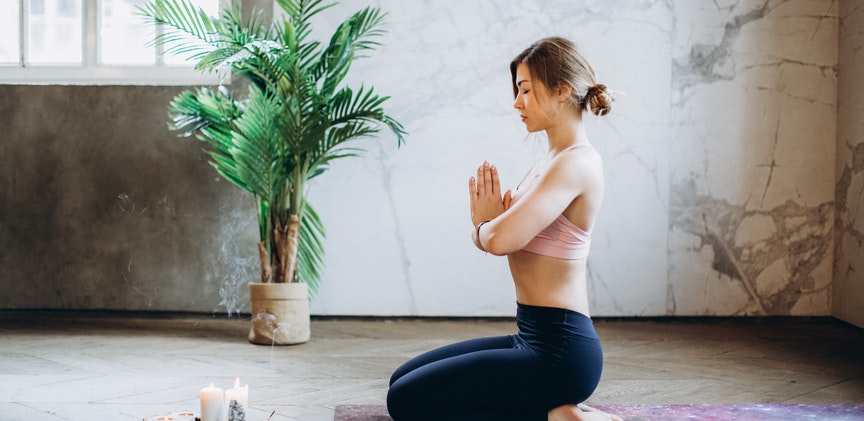My name is Hakima Tantrika and I’m a tantra teacher who has embodied the essence of tantra for the last 10 years. I am also a relationships coach working with clients all over the world who are exposed to narcissists and want to have healthier relationships. I have made it | Read More
Yoni Yoga: What Is It, What Are The Benefits And How To Do It
Have you heard about yoni yoga? Whether you’re new to this practice or already familiar with the concept, this article is for you. Not to be confused with yoni massage, yoni yoga is a practice intended for women of all builds, types, sexualities and cultures. It is used as a daily self-care ritual in order to have a healthy relationship with our womb space. If you’d like to be initiated to this practice, keep reading and you’ll learn everything about yoni yoga, its benefits and how to do it.
What is yoni yoga?
In Sanskrit, yoni means womb, vulva and vagina, and yoga means union. Thus, a simple definition of yoni yoga is a practice that helps you unite with your womb space. It has become more popular throughout the world as more women want to enhance their connection with themselves. When you connect with the most intimate parts of yourself, you set the foundation for becoming physically, emotionally, mentally and spiritually healthy.
Yoni yoga is a sacred and ancient practice. There is some evidence that it dates back to Ancient China; Taoists believed that the key to a healthy mind and body was to have healthy pelvic floor and sex organs. Women used jade eggs to strengthen their vagina and harness their “chi” — aka their life force energy or sexual energy. When this energy is properly channelled, it is said to help the body work in perfect harmony. Here is some more information about chi/Qi, if you’re curious to know more.
Understanding yoni yoga
- Yoni yoga is an ancient practice that is becoming more and more popular nowadays.
- Yoni yoga focuses specifically on the connection with your most intimate parts.
- Yoni yoga uses eggs made of jade or other gemstones such as rose quartz, that are inserted into the vagina.
How does yoni yoga work?
Yoni yoga is a type of yoga that specifically focuses on the pelvic floor, while a jade egg is inserted inside the vagina. Jade eggs, also called yoni eggs, are egg shaped gemstones intended to be placed inside the vagina. The added weight of an egg inside your vagina helps strengthen your pelvic floor muscles during the womb yoga practice.
Yoni yoga follows a series of yoga poses, combined with rhythmic breathing and mindfulness exercises. It can be combined with meditation focused on the womb, called yoni meditation.
What are the benefits of yoni yoga?
Yoni yoga benefits us in many ways, including physically, emotionally and mentally. When you practice yoni yoga, you give yourself time and space to:
- Connect with the most intimate parts of your body.
- Strengthen your pelvic floor muscles.
- Experience stronger orgasms, even multiple orgasm or squirting.
- Cleanse your womb space from trauma.
- Discover and experiment with your sexuality.
Many women have gone through traumatic experiences surrounding the yoni, specifically sexual abuse, miscarriage or infertility problems. For women who have gone through these hardships, being grounded and connected to their intimate body parts can be difficult. Pain is stored in the yoni and halts the creative flow of energy.
Yoni yoga brings us to a place where we are grounded and centred in our bodies. When we create a practice that is safe for ourselves, these traumas can be worked through. So, if you have experienced a traumatic experience surrounding your yoni, allow yourself to choose healing, and dive into the practice of yoni yoga. You can transmute the pain and reach freedom, as this research paper highlights.
Are there any risks of yoni yoga?
Because the practice of yoni yoga includes the insertion of a jade egg inside the vagina, there are some safety measures to take before starting your practice.
- Make sure you’re using a clean, disinfected yoni egg before your practice. Boil it in clean water for at least 10 minutes before use and allow it to cool.
- Don’t leave your yoni egg in for a long period of time.
- Our body is designed to self-clean. When we have something inside blocking that process, it can lead to potential infections or provoke toxic shock syndrome. Always be mindful of the feelings and sensation in your vagina.
The easiest step to take to prevent any risks when you practice yoni yoga is to always listen to your body. If you feel pain or discomfort during your yoni yoga, remove the egg and rest. You can also prepare your yoni to receive the egg with yoni vaginal steaming.
Yoni yoga techniques
Many women turn to yoni yoga to strengthen their pelvic floor and their vaginal muscles. Doing this can reduce incontinence and release any trauma you may be holding on to. Here are some techniques for you to get introduced to this sacred practice. You can start your yoni yoga journey in the comfort of your home. So without further ado, here are your yoni yoga poses for beginners:
Basic kegel exercises
- In a relaxed sitting position, insert your yoni egg gently. It is important to never force your yoni egg into your vagina. Always be gentle and allow your body to pull the egg in.
- Once your egg is inserted comfortably, get into a lifted kneeling position. Then contract your yoni muscles around the egg. This flexing is similar to when you hold your urine. Hold for ten seconds, release and repeat three times.
Bridge pose
- Lay flat on your back with your knees bent and your feet planted on the ground. Extend your arms down and flatten your hands to the floor.
- Inhale slowly and raise your hips to the ceiling while contracting your pelvic floor muscles.
- Hold for up to a minute and as you exhale release your yoni muscles and lower your hips.
- Repeat as many times as you feel.
Frog pose
- Start in a tabletop position, hands and knees to the floor with a straight back.
- Walk your knees out as far as you can comfortably do so, you should feel a slight stretch in your hips
- As you inhale, do a kegel and elongate your spine and upper body.
- Exhale, release your kegel and relax your spine.
- Repeat as many times as you feel.
Plank pose
- Start with your wrists directly below your shoulders, resting on your forearms. Lift your hips up so you have a straight spine, keeping your neck in line with your spine.
- Straighten your legs and push your heels back, preventing your hips from dropping.
- Engage your abdominal muscles and contract your yoni muscles.
- Hold for 30 seconds to a minute.
Squat pose
- Stand with your legs shoulder-width apart.
- Inhale deeply and slowly squat down as deep as you can go – the deeper the better.
- As you hold this position, contract and release your pelvic floor muscles.
- Repeat for as many reps as you can.
Wall pose
- Start by laying flat on your back with your legs up a wall.
- Inhale deeply and slowly allow your legs to fall to the sides creating a V while also contracting your pelvic floor muscles.
- Exhale and bring your legs back to straight and release your muscles.
- Repeat for as many reps as you desire.
Explore Spiritual Tantric Practices Further With Karma Tantric
At Karma Tantric, we provide spiritual and enlightening tantric massages aimed at connecting you deeply to your every sense. Carried out by trained professionally tantric massage therapists, we offer a wide range of massages to suit every need and preference – including our popular Yoni Tantric Massage. If you’re keen to explore the delights of a tantric massage, get in touch with our friendly team today to book yours.












 KARMA TWEETS
KARMA TWEETS
WHAT’S BEING SAID
Lovely Yasmin, it is great to hear from you. I hope to...
Amazing selfies, they have definitely got me excited for the end of...
It is lovely to read a personal message and to know you...
It is so wonderful to hear all your lovely comments and messages...
This is excellent, thank you! It is nice to see the red...